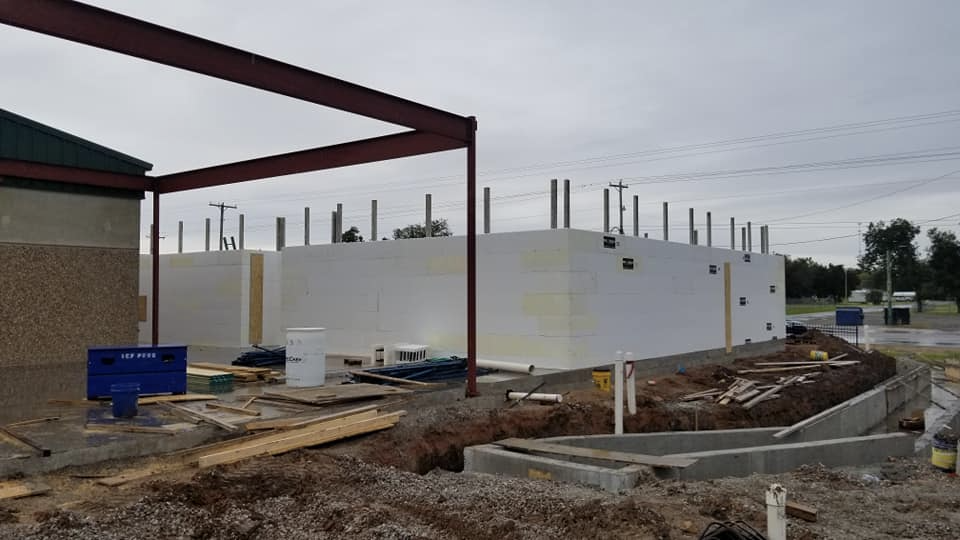
Why Fox Blocks ICF Safe Rooms Provide the Best Protection During Dangerous Wind Events

Safe rooms or shelters, built according to FEMA’s guidelines, provide the best protection for the occupants of residential, commercial, and community spaces against the 1253 tornadoes that occur yearly in the United States. Fox Blocks insulated concrete forms (ICFs) provide an excellent product for a FEMA approved safe room. Fox Blocks ICF safe rooms meet and exceed the criteria for a FEMA safe room design and construction for a continuous load path and impact resistance.
Design Guidelines for a FEMA Safe Room
A FEMA safe room involves a solid space designed and constructed to the guidelines specified in FEMA P-3201, Taking Shelter from the Storm: Building a Safe Room for Your Home or Small Business and FEMA P-3612, Safe Rooms for Tornadoes and Hurricanes: Guidance for Community and Residential Safe Rooms. A FEMA safe room must be designed with a strong continuous load path and resistance to windborne debris, overturning, and uplift. Of importance, the entire envelope of the safe room must meet the structural standards of the ICC- 500.
- The design of the safe room must resist 250 mph winds and the impact of air pressure cycling according to the ASTM E1886/ E1996.
- The wall of the safe room must also withstand debris impact of a 15-pound 2‑inch X 4‑inch shot at 100 mph. The roof must resist the same type of impact, a 15-pound 2‑inch X 4‑inch shot at 67 mph.
Building a Strong Continuous Load Path for a FEMA Approved Safe Room
A strong continuous load path holds together the foundation, walls, and roof of a safe room during a dangerous wind event. The continuous load path ensures that when severe winds attack the roof, the loads move to the shear walls.
Key components of the continuous load path include the safe room's shear walls. The shear walls stop the lateral-loads (horizontal wind forces). The walls must maintain their integrity and have the strength to support the roof, while concurrently transferring the loads to the foundation. Ultimately, the wind loads must travel from the foundation to the ground.
Fox Blocks ICFs offer an excellent FEMA approved product for a safe room in residential, commercial and/or institutional structures. Fox Blocks ICF walls (with steel-reinforced concrete) provide the continuous load path needed to resist the intense wind that exceeds 200 mph during tornadoes and hurricanes. Furthermore, the Fox Blocks wall assembly provides the durability and the strength to support a roof.

Creating ICF Safe Rooms that Protect Against Flying Debris
The whole building envelope of a FEMA approved safe room - the doors, roof, and walls - must protect its occupants from the impact and penetration of flying debris during a severe wind event.
Fox Blocks ICF walls provide an ideal choice for protecting a safe room’s occupants from flying debris during dangerous winds of 100+ mph. It’s important to know that Fox Blocks ICF walls produce more resistance to damage from flying debris than wood-framed walls.

A school safe room, built with Fox Blocks, serves the important service of protecting children from a disaster like what happened in 2013 in Moore, Oklahoma. During this devastating event, a tornado with winds of 210 mph hit and destroyed two elementary schools — resulting in the death of seven children. The buildings collapsed due to structural deficiencies. A FEMA approved safe room in the schools could have prevented this tragedy.
Designing FEMA Safe Rooms that Resists Uplift and Overturning
Properly anchoring a safe room to its foundation prevents overturning and uplift as it receives the wind forces from the shear walls. The design and anchoring of the slab-on-grade foundation must adhere to the requirements in FEMA P-361, as defined by the ICC-500 (Section 308.1.1.2).
The growing need for safe rooms in residential, commercial, and community buildings correlates with more frequent and extreme weather events. Sadly, as of June 2019, 38 people have already died as a result of tornados. A safe room designed and built by FEMA guidelines ensures maximum protection for its occupants during severe wind events. A safe room constructed with Fox Blocks meets and surpasses the requirements for a FEMA safe room design for impact resistance and a continuous load path and ensure its occupants’ safety during a dangerous wind event.
1FEMA P‑320 — Taking Shelter from the Storm — is a guide for homeowners, builders, and contractors, for designing tornado and hurricane safe rooms. The FEMA P‑320 uses ICC-500 as a reference standard.
- Anchor the safe rooms to the building’s foundation to resist overturning and uplift.
- A continuous load path ensures a safe room can resist lateral and uplift loads during high winds.
- The openings, roof, and walls of a safe room must withstand perforation by flying debris.
- The safe room walls are independent of other structures.
2FEMA P‑361 — Safe Rooms for Tornadoes and Hurricanes — a guide for engineers, architects, local officials, building officials, emergency managers, and prospective operators and safe room owners. The FEMA P‑361 provides more technical guidance than the FEMA P‑320.